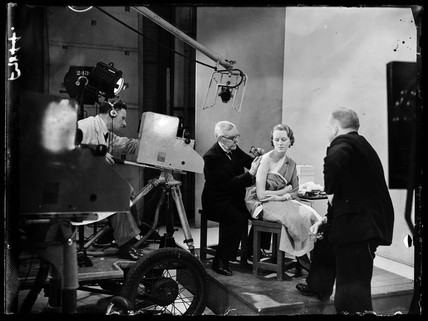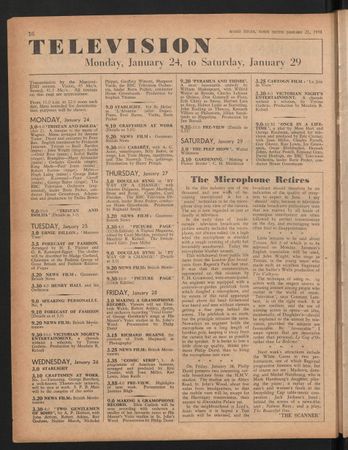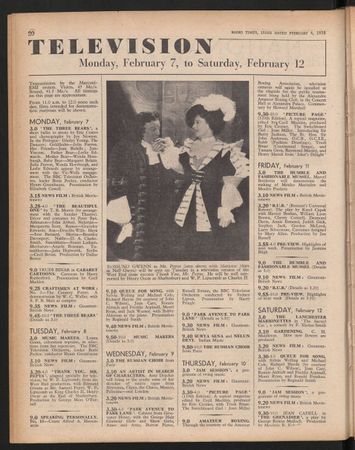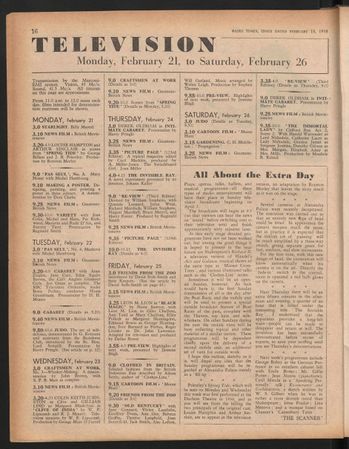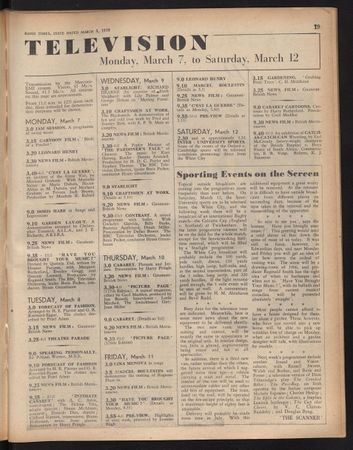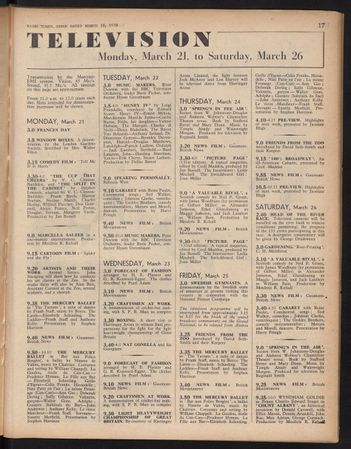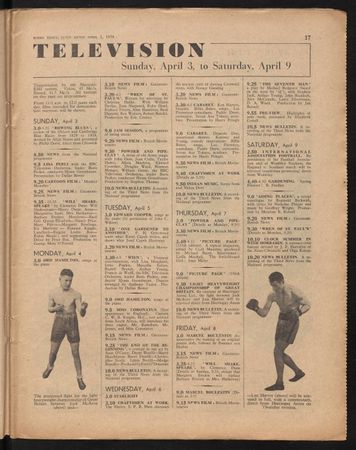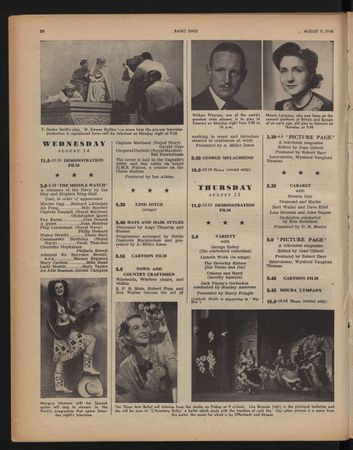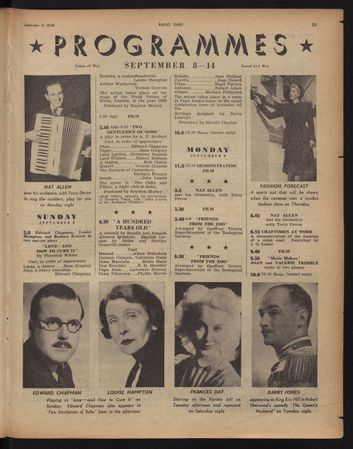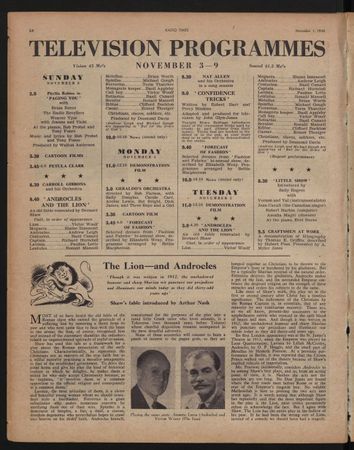Craftsmen at Work (lost early BBC documentary show; 1938, 1946)
Craftsmen at Work is an early BBC documentary television series. Airing in six-parts throughout 1938, and for a short revival in 1946, the show provided practical demonstrations of how crafting jobs were performed, including tattooing and production of cricket bats.
Background
The show's presenter was S. P. B. Mais, a prominent British journalist and broadcaster. According to an obituary published in the 24th April 1975 edition of The Times, Mais proved popular for his documentaries and informal style of presentation.[1] Craftsmen at Work's first episode was broadcast on 26th January 1938, where George Burchett was filmed tattooing a woman inside the Alexandra Palace television studio.[2][3][4] As with most shows of the era, this presentation was repeated later in the evening,[3][4] with new episodes airing roughly on a fortnightly basis. The second episode, airing on 7th February 1938, examined the production of country pottery, with W. C. Waller demonstrating this craft.[5][6]
Following this, whisket-making was showcased on 23rd February, with John Brown detailing how he crafted the straw baskets.[7][8] Blacksmith brothers Fred and Stanley Bish were next to appear, presenting the iron work involved in their craft, which was broadcast on 9th March.[9][10] An unknown individual then detailed the production of cricket bats on the 23rd March edition of the show.[11][12] Horace Gooding concluded the series on 6th April by detailing how the ancient craft of slatting Cotswold stone was performed.[13][14]
Despite no additional episodes being aired prior to the start of the Second World War, Craftsmen at Work would actually make a return in 1946.[15][16] The episodes would have different presenters, including A. Miller Jones and J. G. Links.[15][16][17][18][19][20] However, Mais would make an appearance in the first episode, broadcast on 14th August.[15][16] In it, he, alongside Hubert Foss and Rex Wailes, detailed wood working.[15][16] Following this, Links would describe the process of making mink coats on the 9th September edition of the show.[17][18] Craftsmen at Work fully concluded on 5th November 1946, with Thomas E. Griffits demonstrating lithography.[19][20] While the show may have ended, the BBC were still interested in broadcasting additional craft demonstrations. This included a presentation on the production of chairs, broadcast on 27th October 1947 and presented by Jones.[21] The show's spiritual successor was likely Made by Hand, another show demonstrating the practices of various craftsmen, which ran for ten episodes from October 1949 to April 1950.[22]
Availability
Like all early television transmissions, all episodes of Craftsmen at Work were televised live and there were limited viable means of recording television prior to and soon after the Second World War, with recording seldom having occurred until video tape was perfected in the late-1950s.[23] Thus, all footage from the demonstrations is likely permanently missing. Nevertheless, a photo of Burchett tattooing a woman inside the studio was taken for the Daily Herald newspaper, and remains publicly viewable.[2] Additionally, Radio Times issues helped to document the broadcasts from both pre- and post-Second World War.[4][6][8][10][12][14][16][18][20]
Gallery
Images
See Also
Early BBC Television
- Alexandra Palace's wartime television demonstrations (lost footage of private television transmissions; 1943, 1945)
- An Inspector Calls (lost television adaptation of play; 1948)
- Ann and Harold (lost early BBC drama television series; 1938)
- BBC Election Night (lost coverage of British general elections; 1950-1951)
- The Care of Your Car (lost early BBC motoring show; 1947)
- Cook's Night Out (lost early BBC cooking show; 1937)
- Dish of the Month (lost early BBC cooking show; 1937)
- First Aid (lost early BBC medical show; 1937)
- Foundations of Cookery (lost early BBC cooking show; 1939)
- Marcel Boulestin television shorts (lost early BBC programs; 1937-1939)
- Masks through the Ages (lost early BBC history talk show; 1937)
- Opening of the BBC Television Service (partially found coverage of inaugural day of high-definition television service; 1936)
- The Orchestra and its Instruments (lost early BBC music talk show; 1937)
- RCA recording of BBC Television Service (found footage of pre-Second World War BBC television broadcast; 1938)
- Sea Stories (lost early BBC talk show; 1936-1937)
- Spelling Bee (lost early BBC game show; 1938)
- Telecrime (lost early BBC crime drama; 1938-1939; 1946)
- The Wasp's Nest (lost early BBC television adaptation of Agatha Christie short story; 1937)
- Weaponless Self-Defence (lost early ju-jitsu television program; 1936-1937)
- The World of Women (lost early BBC talk show; 1937)
Early BBC Sports Television
- 1931 Epsom Derby (lost televised footage of horse racing event; 1931)
- 1937 FA Cup Final (partially found footage of football match; 1937)
- 1937 International Imperial Trophy Race (lost footage of motor race; 1937)
- 1937 Wimbledon Championships (partially found footage of tennis tournament; 1937)
- 1938 Ashes Series (partially found footage of international test cricket match; 1938)
- 1938 FA Cup Final (partially found footage of football match; 1938)
- 1939 FA Cup Final (partially found footage of football match; 1939)
- 1947 FA Cup Final (partially found footage of football match; 1947)
- 1953 British Grand Prix (partially found footage of Formula One race; 1953)
- 1955 Scottish Cup Final (partially found footage of football match; 1955)
- Archery (lost early televised toxophily; 1937-1938)
- Arsenal 7-1 Hibernian (lost footage of charity football match; 1952)
- Arsenal vs Arsenal Reserves (lost footage of early BBC televised football match; 1937)
- Barnet 3-2 Wealdstone (lost footage of Athenian League football match; 1946)
- The Boat Race 1938 (partially found footage of rowing race; 1938)
- Catch-As-Catch-Can Wrestling (lost early BBC televised professional wrestling matches; 1938-1939; 1946-1947)
- Charlton Athletic 1-0 Blackburn Rovers (lost footage of FA Cup match; 1947)
- Darts and Shove Ha'penny (lost early BBC televised darts matches; 1936-1939)
- England 0-1 Scotland (partially found international football match; 1938)
- England 1-1 Scotland (partially found footage of international football match; 1947)
- England 16-21 Scotland (partially found footage of rugby match; 1938)
- England 3-0 France (partially found footage of international football match; 1947)
- England 3-0 Rest of Europe (partially found footage of international football match; 1938)
- Falkirk 3-2 Newcastle United (lost footage of football match; 1953)
- Horace Lindrum vs Willie Smith (lost footage of televised snooker; 1937)
- Scottish Universities 1-1 English Universities (lost footage of international football match; 1952)
- Woods and Jack (lost early televised lawn bowls; 1937; 1946)
External Link
References
- ↑ 24th April 1975 edition of The Times providing an obituary of S. P. B. Mais. Retrieved 29th Jan '22
- ↑ 2.0 2.1 Science & Society providing a photo of Craftsmen at Work and a description of it. Retrieved 29th Jan '22
- ↑ 3.0 3.1 BBC Genome archive of Radio Times issues detailing the tattooing episode. Retrieved 29th Jan '22
- ↑ 4.0 4.1 4.2 Issue 747 of Radio Times listing the tattooing episode. Retrieved 29th Jan '22
- ↑ BBC Genome archive of Radio Times issues detailing the country pottery episode. Retrieved 29th Jan '22
- ↑ 6.0 6.1 Issue 749 of Radio Times listing the country pottery episode. Retrieved 29th Jan '22
- ↑ BBC Genome archive of Radio Times issues detailing the whisket episode. Retrieved 29th Jan '22
- ↑ 8.0 8.1 Issue 751 of Radio Times listing the whisket episode. Retrieved 29th Jan '22
- ↑ BBC Genome archive of Radio Times issues detailing the blacksmith episode. Retrieved 29th Jan '22
- ↑ 10.0 10.1 Issue 753 of Radio Times listing the blacksmith episode. Retrieved 29th Jan '22
- ↑ BBC Genome archive of Radio Times issues detailing the cricket bat episode. Retrieved 29th Jan '22
- ↑ 12.0 12.1 Issue 755 of Radio Times listing the cricket bat episode. Retrieved 29th Jan '22
- ↑ BBC Genome archive of Radio Times issues detailing the slatter episode. Retrieved 29th Jan '22
- ↑ 14.0 14.1 Issue 757 of Radio Times listing the slatter episode. Retrieved 29th Jan '22
- ↑ 15.0 15.1 15.2 15.3 BBC Genome archive of Radio Times issues detailing the wood working episode. Retrieved 29th Jan '22
- ↑ 16.0 16.1 16.2 16.3 16.4 Issue 1193 of Radio Times listing the wood working episode. Retrieved 29th Jan '22
- ↑ 17.0 17.1 BBC Genome archive of Radio Times issues detailing the mink coat episode. Retrieved 29th Jan '22
- ↑ 18.0 18.1 18.2 Issue 1197 of Radio Times listing the mink coat episode. Retrieved 29th Jan '22
- ↑ 19.0 19.1 BBC Genome archive of Radio Times issues detailing the lithography episode. Retrieved 29th Jan '22
- ↑ 20.0 20.1 20.2 Issue 1205 of Radio Times listing the lithography episode. Retrieved 29th Jan '22
- ↑ BBC Genome archive of Radio Times issues detailing What's in a Chair?. Retrieved 29th Jan '22
- ↑ BBC Genome archive of Radio Times issues detailing the stained glass episode of Made by Hand. Retrieved 29th Jan '22
- ↑ Web Archive article discussing how most early television is missing due to a lack of direct recording of television. Retrieved 29th Jan '22
